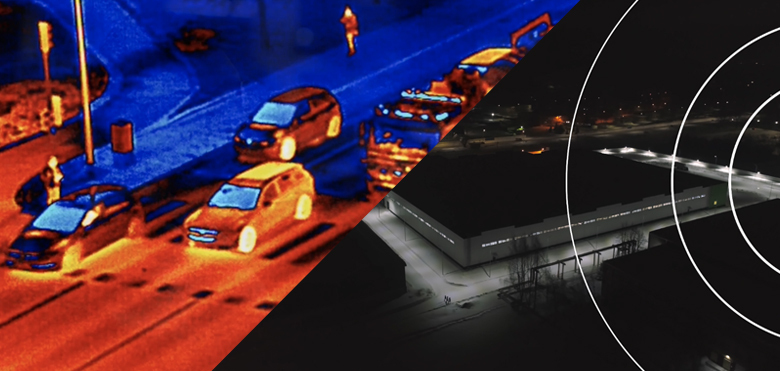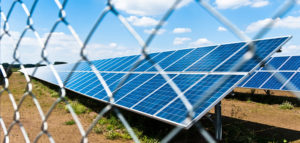Thermal and radar: sight where there’s no light
This post is a collaboration between Magnus Lundegård & Niklas Lindman, Global Product Managers Thermal and Radar.
Modern surveillance cameras are loaded with technology that helps maintain a high-quality view of a scene in low-light and challenging conditions. But in situations where there is no ambient light at all – or where it would be undesirable to illuminate a scene – a different solution is needed. Thermal cameras and radar provide the answer.
No place to hide with thermal cameras
Thermal cameras make use of something emitted by any object, whether organic or inorganic, and which none of us can stop: infrared energy or, in simplified terms, heat. In less simpler terms, infrared energy is electromagnetic radiation (EMR) with wavelengths longer than those of visible light.
While not visible to the human eye – or traditional video surveillance cameras – thermal camera sensors detect infrared energy and form it into images where different colours, tones, or shades represent different levels of heat.
Given that thermal cameras do not rely on visible light to create images, they provide the same quality of image, day or night. They’re effective in complete darkness, dense fog, where smoke obscures a view, or if people or animals are doing their best to camouflage themselves. They essentially make the invisible, visible.
The capabilities of thermal cameras make them ideal for detection and to assist in verification of security issues. For example, a thermal camera might detect an individual approach a perimeter fence in darkness, and then trigger a PTZ video surveillance camera and lighting to illuminate the scene for visual identification. Recorded audio warnings and messages can also be automatically triggered, or allow security personnel to respond directly with live audio.
A role for thermal cameras in operational monitoring
Thermal cameras can do much more than keep perimeters secure. Their ability to identify changes in temperature bring benefits on operational monitoring. Alongside applications such as automated flare monitoring in the oil & gas production industry, thermal cameras can detect heat leaks in buildings and processes, identifying dangerous temperature variances in processes and triggering alarms before situations escalate and become a more serious risk.
Protecting privacy
A further benefit of thermal cameras is their ability to provide useful images while also protecting the privacy of individuals. When used in healthcare, senior living or similar, thermal cameras with embedded motion-detection analytics protect personal privacy while quickly alerting staff to unexpected motion that might mean a patient has fallen or needs medical assistance. Their highly discreet design also helps minimize the feeling of being watched so people can rest easier.
Adding the benefits of radar technology
Radar is something that most people will have some knowledge of, probably due to its historical use in applications such as traffic monitoring and airplane guidance. There can’t be many people who haven’t watched an action movie and seen some sort of unidentified object appearing on a radar screen…
The same features have become used by the security industry to integrate radar as a technology into surveillance solutions. The ability of radar as a so-called ‘blind’ technology – being able to provide accurate data regarding the classification of an object (for instance as either a vehicle or a human) and its speed, velocity, and angle, without visually defining it – brings a number of benefits in surveillance.
A quick lesson in radar
A radar device transmits signals consisting of harmless radio waves. When the radio waves hit a moving object, the signal is reflected back to the radar device, where it will be analyzed by a receiver. This enables the technology to provide information on an object’s classification and position, and determine its speed, radar cross section, and direction of travel. This is useful in itself, and when combined with video surveillance cameras – where, for instance, the radar could ‘instruct’ a PTZ camera to follow the object – provides comprehensive surveillance cover.
More accuracy means fewer false alarms
Being able to automatically detect something that has entered any area and distinguish whether or not it is a real threat without sending out security teams immediately brings savings in costs and resources. Motion detection with radar differentiates itself from standard video motion detection, as it picks up on the changes in radio wave frequency instead of pixels, which provides information from different technologies and can help reduce the number of false alarms.
This can be best explained by looking at what doesn’t trigger a radar, rather than what does. A radar will not be triggered by a slight change in image pixels, unlike like a visual camera when lights, a spider web, or a fallen branch come across its field of view. Instead, it’s about the radio waves bouncing off certain objects and back to the radar’s receiver. By being able to set sensitivity levels, using advance signal processing algorithms and deep learning technology on radar products to detect moving objects and their class, an alarm will not, for example, be triggered by a rabbit, cat, or other small animals that run through the perimeter and pose no threat.
Ideal use cases for radar
Radar works standalone to detect, classify and track moving objects in large areas, and can also be used as an added method of protection to complement and strengthen visual surveillance systems, resulting in a more accurate and reliable security solution.
Modern radar surveillance systems work well in wide open areas with moderate levels of activity. A good example would be logistics centers and warehouses, which often keep stock outside but are closed at night. Even where light conditions are poor or non-existent, radar can still enable detection of objects passing through the area. Indeed, the use of radar can reduce the power consumption needed for artificial light at night, this only being required if the radar detects movement and activates video surveillance cameras.
In this scenario the radar’s information can be used to trigger a security sequence if a threat is authentic. Radar can automatically trigger and steer a PTZ video camera so that it keeps track of the detected object. Floodlights can come on to scare the intruder and provide light for improved image quality, with recorded messages played over horn speakers to tell the intruders they are being watched.
As well as saving costs from not having the cameras and lights on all the time and a security guard on site, it also reduces the losses associated with the theft of the stock.
Thermal, radar, and video: effective individually, phenomenal together
Used in conjunction with video surveillance, thermal cameras and radar devices provide total coverage and optimize security systems. Threats can be detected earlier and more accurately, false alarms reduced, automated responses used more effectively, and security personnel deployed only where absolutely necessary. It’s easy to think that it’s a choice between these technologies. While individually each has clear strengths, the maximum benefit is realized when they are used to complement each other.
See the whole picture, click here.




